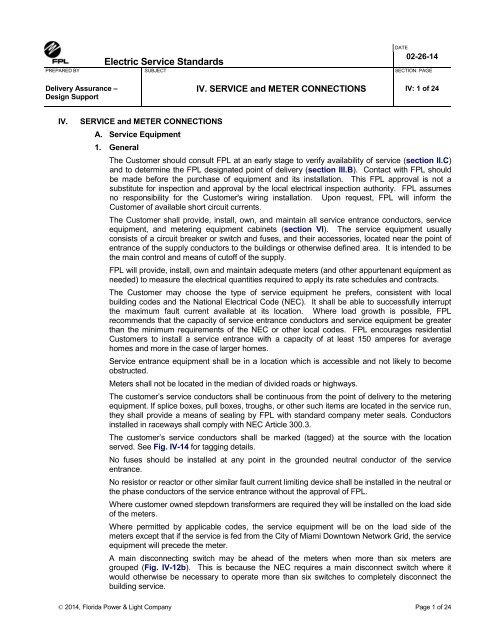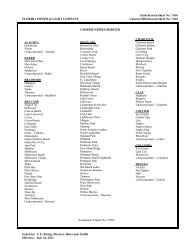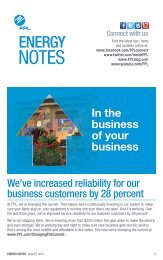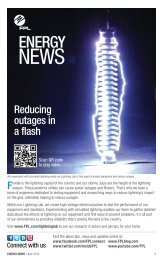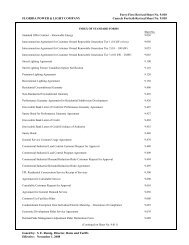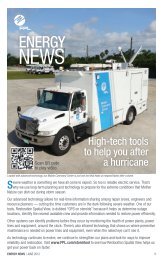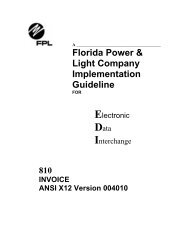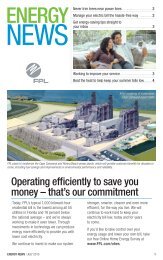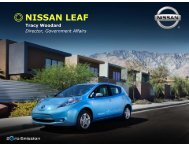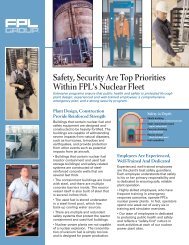Electric Service Standards - FPL.com
Electric Service Standards - FPL.com
Electric Service Standards - FPL.com
Create successful ePaper yourself
Turn your PDF publications into a flip-book with our unique Google optimized e-Paper software.
PREPARED BY<br />
<strong>Electric</strong> <strong>Service</strong> <strong>Standards</strong><br />
SUBJECT<br />
DATE<br />
02-26-14<br />
SECTION: PAGE<br />
Delivery Assurance –<br />
Design Support<br />
IV. SERVICE and METER CONNECTIONS<br />
IV: 1 of 24<br />
IV.<br />
SERVICE and METER CONNECTIONS<br />
A. <strong>Service</strong> Equipment<br />
1. General<br />
The Customer should consult <strong>FPL</strong> at an early stage to verify availability of service (section II.C)<br />
and to determine the <strong>FPL</strong> designated point of delivery (section III.B). Contact with <strong>FPL</strong> should<br />
be made before the purchase of equipment and its installation. This <strong>FPL</strong> approval is not a<br />
substitute for inspection and approval by the local electrical inspection authority. <strong>FPL</strong> assumes<br />
no responsibility for the Customer's wiring installation. Upon request, <strong>FPL</strong> will inform the<br />
Customer of available short circuit currents.<br />
The Customer shall provide, install, own, and maintain all service entrance conductors, service<br />
equipment, and metering equipment cabinets (section VI). The service equipment usually<br />
consists of a circuit breaker or switch and fuses, and their accessories, located near the point of<br />
entrance of the supply conductors to the buildings or otherwise defined area. It is intended to be<br />
the main control and means of cutoff of the supply.<br />
<strong>FPL</strong> will provide, install, own and maintain adequate meters (and other appurtenant equipment as<br />
needed) to measure the electrical quantities required to apply its rate schedules and contracts.<br />
The Customer may choose the type of service equipment he prefers, consistent with local<br />
building codes and the National <strong>Electric</strong>al Code (NEC). It shall be able to successfully interrupt<br />
the maximum fault current available at its location. Where load growth is possible, <strong>FPL</strong><br />
re<strong>com</strong>mends that the capacity of service entrance conductors and service equipment be greater<br />
than the minimum requirements of the NEC or other local codes. <strong>FPL</strong> encourages residential<br />
Customers to install a service entrance with a capacity of at least 150 amperes for average<br />
homes and more in the case of larger homes.<br />
<strong>Service</strong> entrance equipment shall be in a location which is accessible and not likely to be<strong>com</strong>e<br />
obstructed.<br />
Meters shall not be located in the median of divided roads or highways.<br />
The customer’s service conductors shall be continuous from the point of delivery to the metering<br />
equipment. If splice boxes, pull boxes, troughs, or other such items are located in the service run,<br />
they shall provide a means of sealing by <strong>FPL</strong> with standard <strong>com</strong>pany meter seals. Conductors<br />
installed in raceways shall <strong>com</strong>ply with NEC Article 300.3.<br />
The customer’s service conductors shall be marked (tagged) at the source with the location<br />
served. See Fig. IV-14 for tagging details.<br />
No fuses should be installed at any point in the grounded neutral conductor of the service<br />
entrance.<br />
No resistor or reactor or other similar fault current limiting device shall be installed in the neutral or<br />
the phase conductors of the service entrance without the approval of <strong>FPL</strong>.<br />
Where customer owned stepdown transformers are required they will be installed on the load side<br />
of the meters.<br />
Where permitted by applicable codes, the service equipment will be on the load side of the<br />
meters except that if the service is fed from the City of Miami Downtown Network Grid, the service<br />
equipment will precede the meter.<br />
A main disconnecting switch may be ahead of the meters when more than six meters are<br />
grouped (Fig. IV-12b). This is because the NEC requires a main disconnect switch where it<br />
would otherwise be necessary to operate more than six switches to <strong>com</strong>pletely disconnect the<br />
building service.<br />
© 2014, Florida Power & Light Company Page 1 of 24
PREPARED BY<br />
<strong>Electric</strong> <strong>Service</strong> <strong>Standards</strong><br />
SUBJECT<br />
DATE<br />
02-26-14<br />
SECTION: PAGE<br />
Delivery Assurance –<br />
Design Support<br />
IV. SERVICE and METER CONNECTIONS<br />
IV: 2 of 24<br />
When installed ahead of the meters, the door of the main switch shall be sealable in both the "on"<br />
and "off" positions. The handle shall be sealable in the "off" position.<br />
A minimum horizontal separation of 3 feet shall be maintained between natural gas service<br />
equipment (vented regulators) and electric metering or termination equipment. Transformers<br />
shall have a minimum separation of 5 feet from natural gas service equipment. A minimum<br />
separation of 5’ shall be maintained between electric metering or termination equipment and<br />
liquid petroleum facilities on site but not filled on site. If the liquid petroleum facilities are filled<br />
on site the minimum separation is 10 feet.<br />
All <strong>com</strong>mercial installations and all residential three phase installations must contain lever bypass,<br />
jaw tension/release socket blocks with the exception of small (120V or 120/240V, with 100 amp<br />
meter enclosure), non-critical loads such as:<br />
• Lighted signs and billboards<br />
• Temporary construction poles and service to construction trailers<br />
• Irrigation pumps<br />
• Residential detached garages<br />
• Gate openers<br />
• Barns<br />
• Apartment / Condo house meters<br />
• Bus stops<br />
• Street lighting<br />
The use of a Metallic fishtape to pull service conductors into <strong>FPL</strong> owned equipment is not<br />
allowed.<br />
2. Ampere Rating<br />
a. Residential<br />
The rating of the service entrance equipment shall satisfy the general requirements stated<br />
above, the NEC and local building codes. Article 230 of the NEC states that the minimum<br />
rating for a one family dwelling with six or more two-wire branch circuits, or an initial<br />
<strong>com</strong>puted load of 10 kVA or more is 100 ampere, three-wire. For dwelling units with less<br />
load, as <strong>com</strong>puted in accordance with NEC guidelines, the minimum may be 60 ampere,<br />
three wire if approved by the inspecting authority. In very special cases where the load is<br />
only one or two two-wire branch circuits, the service disconnecting means may have a rating<br />
of no less than 15 amperes or 30 amperes, respectively, if approved by the inspecting<br />
authority.<br />
As stated previously, <strong>FPL</strong> re<strong>com</strong>mends that the service entrance have more capacity than<br />
the minimum required by the NEC. Local inspecting authorities shall be consulted, since<br />
some locations may have requirements that exceed the minimums.<br />
b. Commercial<br />
The rating of the service equipment for <strong>com</strong>mercial or industrial occupancies will depend on<br />
the connected load, and in most cases, will be specified by the Customer's engineer.<br />
© 2014, Florida Power & Light Company Page 2 of 24
PREPARED BY<br />
<strong>Electric</strong> <strong>Service</strong> <strong>Standards</strong><br />
SUBJECT<br />
DATE<br />
02-26-14<br />
SECTION: PAGE<br />
Delivery Assurance –<br />
Design Support<br />
IV. SERVICE and METER CONNECTIONS<br />
IV: 3 of 24<br />
It is important that the requirements be reviewed with <strong>FPL</strong> at an early date so that a<br />
satisfactory solution as to service voltage and service entrance location can be determined.<br />
At this time, details as to the nature and size load to be served may be given to <strong>FPL</strong>, if this<br />
has not already been done.<br />
The service equipment should be chosen to satisfy all the requirements of the Customer for<br />
the control of his load and should be consistent with the NEC, local building codes and the<br />
rules of the inspecting authority.<br />
One requirement is that the service equipment shall be able to safely interrupt the maximum<br />
fault current available at its location. Upon request, <strong>FPL</strong> will supply information which will<br />
permit the maximum available fault current to be determined.<br />
<strong>FPL</strong> emphasizes that changes in the Customer's load and other loads in the area may require<br />
changes in <strong>FPL</strong>'s system. These changes may increase the available fault current.<br />
Allowance should be made for this possible increase.<br />
c. <strong>Service</strong> Equipment Rated Below 600 Volts<br />
In those cases where the Customer's ampere demand at these voltages exceeds 600<br />
amperes, or the Customer's service entrance wire size exceeds 1-800 KCMIL or 2-500<br />
KCMIL conductors, per phase, <strong>FPL</strong> will normally require the Customer to furnish a current<br />
transformer cabinet and an instrument transformer rated meter socket, installed ahead of his<br />
service equipment. The Customer will also furnish and install a 1-1/2 inch conduit from the<br />
cabinet to the meter socket (refer to the specifications found in section VI). <strong>FPL</strong> will provide<br />
and perform the current transformer installation, install the secondary wiring from the current<br />
transformer to the meter socket, and install the meter.<br />
On all self-contained metered installations (320 amperes or less) where the service voltage is<br />
480V to ground (2 wire), a non-automatic disconnect device shall be provided and installed<br />
by the Customer on the line side of each individual meter. The disconnect device shall be<br />
lockable or sealable by <strong>FPL</strong> and adjacent to each meter. The Customer-owned nonautomatic<br />
(no over current protection) disconnect device ampacity must meet all NEC<br />
Guidelines. A lever bypass equipped meter enclosure is required and shall be selected from<br />
the Approved Meter Equipment Enclosure List.<br />
For service disconnecting means rated 1,000 amperes or more used on a solidly grounded<br />
277/480 volt wye service, ground-fault protection shall be provided. This may be omitted, if<br />
approved by the inspecting authority or if the service equipment controls a continuous<br />
industrial process where a non-orderly shutdown would otherwise introduce additional or<br />
increased hazards.<br />
Where for any reason, a main disconnecting switch is required in multi-metered service<br />
installations; it will be on the line side of the meters. The door of this switch box shall be<br />
sealable. No socket or current transformer cabinet will be required ahead of this switch.<br />
d. <strong>Service</strong> Equipment Rated Over 600 Volts<br />
When the Customer takes service at primary voltage, he shall provide service equipment<br />
rated for the voltage supplied. The service equipment will normally be on the load side of<br />
<strong>FPL</strong>'s instrument transformer metering installation.<br />
© 2014, Florida Power & Light Company Page 3 of 24
PREPARED BY<br />
<strong>Electric</strong> <strong>Service</strong> <strong>Standards</strong><br />
SUBJECT<br />
DATE<br />
02-26-14<br />
SECTION: PAGE<br />
Delivery Assurance –<br />
Design Support<br />
IV. SERVICE and METER CONNECTIONS<br />
IV: 4 of 24<br />
The service equipment shall satisfy all the requirements of the NEC, the building code, and<br />
the inspecting authority.<br />
<strong>FPL</strong> shall be consulted so that the Customer's primary service equipment may be<br />
coordinated with <strong>FPL</strong>'s feeder protection circuit breakers and fuses.<br />
For padmounted primary metering, the customer will either provide a metering cabinet listed<br />
on <strong>FPL</strong>’s approved enclosure list, or <strong>FPL</strong> will provide the metering cabinet and bill the<br />
customer the cost. For primary metering in vaults, <strong>FPL</strong> will provide, own, and maintain the<br />
metering cabinet located inside the vault.<br />
B. Overhead <strong>Service</strong><br />
For residential overhead service, the attachment will normally be within ten feet of the corner, on<br />
the side of the building nearest <strong>FPL</strong>'s secondary facilities (Fig. IV-4). The Customer's service<br />
entrance should be installed in such fashion that service drop wires will not cross over buildings,<br />
swimming pools, or adjacent property not owned by the Customer. <strong>FPL</strong> may provide the<br />
Customer with two copies of an "<strong>Electric</strong> <strong>Service</strong> and Meter Location" sketch (<strong>FPL</strong> form 1453)<br />
confirming the service location (Fig. IV-3).<br />
1. Vertical Clearance to Ground<br />
The point of attachment for service drops not exceeding 150 volts from any conductor to ground<br />
shall allow ten feet of ground clearance to lowest point of sag in the service drop.<br />
<strong>Service</strong> drops exceeding 150 volts but less than 300 volts from any conductor to ground shall<br />
allow ten & one-half feet of ground clearance to lowest point of sag.<br />
Where the service drop must pass over immediately adjacent driveways or parking areas subject<br />
to truck traffic or if it is within 25 feet of a swimming pool or if the voltage to ground is over 300<br />
volts, additional clearance shall be provided. In these cases a greater attachment height shall be<br />
provided.<br />
The required attachment height will be shown on the "<strong>Electric</strong> <strong>Service</strong> & Meter Location" sketch.<br />
It is important the Customer furnish this information to the building contractor and electrician.<br />
2. Clearance from Building Openings<br />
<strong>Service</strong> conductors shall have a clearance of not less than three feet from windows, doors,<br />
porches, fire escapes or similar openings.<br />
3. Clearance from Swimming Pools<br />
<strong>FPL</strong> prefers a minimum horizontal clearance of 10 feet from its facilities to swimming pool edges<br />
or pool enclosures. However if certain conditions are met, including minimum vertical clearances,<br />
the National <strong>Electric</strong>al Safety Code (NESC) provides for less than 10 feet of horizontal separation.<br />
Costly relocations of existing services may be<strong>com</strong>e necessary if the Customer builds a pool too<br />
near <strong>FPL</strong>'s electric facilities. Should there be any question of conflict between the location of a<br />
new swimming pool or pool enclosure and <strong>FPL</strong>’s facilities; the Customer is to contact <strong>FPL</strong> before<br />
construction of the pool facilities to ensure required NESC clearances are met.<br />
© 2014, Florida Power & Light Company Page 4 of 24
PREPARED BY<br />
<strong>Electric</strong> <strong>Service</strong> <strong>Standards</strong><br />
SUBJECT<br />
DATE<br />
02-26-14<br />
SECTION: PAGE<br />
Delivery Assurance –<br />
Design Support<br />
IV. SERVICE and METER CONNECTIONS<br />
IV: 5 of 24<br />
4. Anchorage for Overhead <strong>Service</strong> Drop Cable or Wires<br />
The Customer shall provide a safe and adequate anchorage for <strong>FPL</strong>'s overhead service drop<br />
conductors at the agreed upon location and height.<br />
<strong>FPL</strong> will furnish, and the Customer will install, a suitable attachment for the service drop. The<br />
attachment device furnished will vary, to be <strong>com</strong>patible with the type of building construction (Fig.<br />
IV-6a thru 6c).<br />
<strong>FPL</strong> WILL NOT BE RESPONSIBLE FOR DAMAGE TO THE CUSTOMER'S BUILDING OR<br />
WIRING RESULTING FROM FAILURE OF THIS ANCHORAGE.<br />
The point of service drop attachment and its height will be shown on the "<strong>Electric</strong> <strong>Service</strong> and<br />
Meter Location" sketch. It should be sufficient to provide all the required clearances as shown in<br />
Fig. IV-5. The location should be accessible from the ground by a ladder.<br />
Where the height of the building would not allow adequate clearance from service drop to ground,<br />
the Customer shall furnish and install a service mast or other approved extension (Fig. IV-6a).<br />
<strong>FPL</strong> will provide and install the bracket for attaching the service drop to the service mast.<br />
5. Installation of <strong>Service</strong> Entrance<br />
The service entrance conductors shall be provided and installed by the customer in accordance<br />
with local building codes and the latest NEC. The conductors will extend a minimum of 36 inches<br />
beyond the service weatherhead to permit connection to <strong>FPL</strong>’s service drop wires. <strong>FPL</strong> limits the<br />
number of customer conductors per service to three per phase (i.e. - 3 weatherheads with one<br />
conductor per phase; or 2 weatherheads - one with parallel conductors and one with single<br />
conductors; or 1 weatherhead with three conductors per phase where allowed by code). Call your<br />
local new construction office in situations where the load exceeds the capacity of three 750<br />
KCMIL AL or CU conductors per phase.<br />
The service entrance weatherhead shall be above the service drop attachment. If this is<br />
impractical, the weatherhead shall not be farther than 24" from the point of attachment.<br />
<strong>Service</strong> drop conductors and service entrance conductors will be arranged in a manner that will<br />
prevent water from getting into the service entrance raceway or cable sheath (Fig. IV-6a).<br />
The neutral conductor of the service entrance shall be identified by the Customer.<br />
Wiring of the meter socket shall be as shown in the appropriate sketch of Fig. IV-8.<br />
The service entrance conduit is installed by the Customer from the service weatherhead to the<br />
meter socket or the service entrance equipment, when this precedes the meter. It may be either<br />
exposed on the exterior building wall, or concealed within the structure itself in a permanently<br />
inaccessible location. Condulets (such as LB, LL, LR) shall not be used. Where exposed to the<br />
weather, conduit shall have threaded joints and shall be arranged to drain.<br />
In the case of the service entrance conductors for a three phase, four wire delta service, one of<br />
the ungrounded conductors will have a higher voltage to ground than the other two conductors<br />
(Fig. IV-8, Meter Symbol J). This conductor shall be durably and permanently marked by an<br />
outer finish that is orange in color or by other durable effective means, and landed on the right<br />
side of the meter can. This marking will ensure connection to the proper <strong>FPL</strong> conductor when the<br />
service is connected.<br />
C. Illustrations<br />
The following illustrations contain pertinent information regarding the installation and connection of<br />
overhead and underground services.<br />
© 2014, Florida Power & Light Company Page 5 of 24
PREPARED BY<br />
<strong>Electric</strong> <strong>Service</strong> <strong>Standards</strong><br />
SUBJECT<br />
DATE<br />
02-26-14<br />
SECTION: PAGE<br />
Delivery Assurance –<br />
Design Support<br />
IV. SERVICE and METER CONNECTIONS<br />
IV: 6 of 24<br />
FIGURE IV-1<br />
Temporary/Construction <strong>Service</strong> - from Overhead System (typical)<br />
10’ 8’<br />
For prompt electric service, set<br />
temporary pole as detailed<br />
10’ – 12’<br />
Direction of <strong>FPL</strong> pole<br />
4” x 4” Pole<br />
<strong>Service</strong> Drop<br />
Cable<br />
Brace Attachment<br />
10’<br />
Min 8'<br />
Min<br />
5’ Min<br />
6’ Max<br />
Point of attachment shall provide clearances<br />
as shown in Fig. IV-5<br />
Meter<br />
Weatherproof<br />
Switch<br />
12” Min<br />
Ground Wire enclosed in<br />
PVC conduit where required<br />
3’ Min<br />
Ground Rod<br />
Driven minimum of 8’<br />
Notes:<br />
1. Before service can be run, Company must have an electrical inspection;<br />
necessary tree trimming shall be done by the customer; and the deposit and<br />
non-refundable temporary service charge shall be paid.<br />
2. <strong>Service</strong> pole shall not be within 25 ft. of swimming pool and must provide<br />
clearances shown in Fig. IV-5.<br />
3. Unspliced timbers are required (minimum length of 12 ft. for 2x4 braces and 16<br />
ft. for 4x4 posts. Use ten penny (10d) nails (3" long).<br />
4. Special arrangements shall be made with <strong>FPL</strong> if service drop exceeds 80 ft. or<br />
is larger than 200 amp capacity.<br />
5. Minimum typical requirements are shown. If local code requirements are more<br />
stringent, they shall be adhered to.<br />
6. The surface the meter socket is mounted on shall be plumb so the meter<br />
socket jaws are truly vertical. The meter enclosure must be on <strong>FPL</strong>’s approved<br />
list.<br />
7. Where acceptable to the inspecting authority, an 18 ft. treated pole (5" min.<br />
diameter at the top) may be substituted for the 4x4 timber and braces,<br />
provided the pole is set 5 ft. deep and well tamped. All other<br />
requirements remain the same.<br />
© 2014, Florida Power & Light Company Page 6 of 24
PREPARED BY<br />
<strong>Electric</strong> <strong>Service</strong> <strong>Standards</strong><br />
SUBJECT<br />
DATE<br />
02-26-14<br />
SECTION: PAGE<br />
Delivery Assurance –<br />
Design Support<br />
IV. SERVICE and METER CONNECTIONS<br />
IV: 7 of 24<br />
FIGURE IV-2<br />
Temporary/Construction <strong>Service</strong> - from Underground System (typical)<br />
4X4 Treated Post<br />
4x4 treated wood post, slotted angle, or<br />
angle iron support for switch and meter.<br />
If desired, customer's switch may be above meter, if post<br />
and angle braces are extended to give needed height.<br />
Angle Braces<br />
Customer's weatherproof<br />
fuse switch installation shall<br />
<strong>com</strong>ply with local code.<br />
Meter<br />
Customer's Meter Socket<br />
3' Min<br />
6’ Max<br />
Customer's conduit<br />
in accordance with<br />
local code authority<br />
Customer's<br />
PVC conduit for<br />
ground wire<br />
Angle Braces only<br />
necessary in unstable<br />
soil.<br />
3'<br />
See Note 2<br />
<strong>Service</strong> Handhole<br />
Ground wire to grounding<br />
electrode or Ground Rod.<br />
(See Note 3)<br />
Notes:<br />
1. Before service can be connected, the <strong>com</strong>pany must have the electrical inspection; necessary grading shall be done by the<br />
customer; and the deposit and non-refundable temporary service charge shall be paid. Contact the <strong>FPL</strong> representative for<br />
availability and location.<br />
2. The customer shall leave a five foot length of service conductor above ground, outside of source, for connection to <strong>FPL</strong> secondary<br />
by <strong>FPL</strong>.<br />
3. Temporary service should be located outside the utility easement to avoid driving the ground rod into any existing underground<br />
cables.<br />
4. <strong>Service</strong> Conductors shall be near secondary side of the transformer.<br />
5. The meter enclosure must be on <strong>FPL</strong>’s approved list.<br />
Padmounted Transformer<br />
See Note 2<br />
Bushing<br />
© 2014, Florida Power & Light Company Page 7 of 24
PREPARED BY<br />
<strong>Electric</strong> <strong>Service</strong> <strong>Standards</strong><br />
SUBJECT<br />
DATE<br />
02-26-14<br />
SECTION: PAGE<br />
Delivery Assurance –<br />
Design Support<br />
IV. SERVICE and METER CONNECTIONS<br />
IV: 8 of 24<br />
FIGURE IV-3<br />
<strong>FPL</strong> <strong>Electric</strong> <strong>Service</strong> and Meter Socket Requirements Form<br />
APPLICANT<br />
Current <strong>FPL</strong> Account No. _____________________<br />
MAILING ADDRESS CITY, ZIP CODE __________ ______________<br />
SERVICE ADDRESS/LEGAL DESCRIPTION<br />
PHONE (WEEKDAYS) DATE _____________________ _______<br />
<strong>FPL</strong> is pleased to advise that electric service for your proposed<br />
will be available from our Distribution facilities as shown<br />
on the sketch below. We understand you are requesting Overhead Underground, volts, phase service. The items checked below<br />
and receipt by our representative of the white copy of this form with your signature acknowledging your receipt, are required before <strong>FPL</strong> provides<br />
electric service:<br />
Payment:<br />
(Check or<br />
Money Order)<br />
Construction/Temporary <strong>Service</strong> Charge:<br />
Security Deposit for Construction/Temporary <strong>Service</strong>:<br />
$ _________<br />
$ _________<br />
Underground/Overhead Differential Charge for Permanent <strong>Service</strong>:<br />
$ _________<br />
Line Extension Contribution In Aid of Construction (CIAC):<br />
Total:<br />
$ _________<br />
$ __________<br />
Tree Trimming & Clearing:<br />
Feet<br />
Each Side of Proposed Line<br />
Installation of Meter Socket & Downpipe/<br />
Weatherhead according to <strong>FPL</strong> Specifications<br />
(see checklist on reverse side of this sheet)<br />
Install eyebolt (for <strong>FPL</strong> to attach wires to)<br />
Configuration Meter Socket*<br />
*Meter socket must be approved for use in <strong>FPL</strong> service area.<br />
Current list of approved sockets available upon request. Socket<br />
configurations are shown on reverse side of this form.<br />
Site Plan <strong>Electric</strong>al Load Information/Plans<br />
Easement for <strong>FPL</strong> Facilities/Legal Description of Property<br />
Contact <strong>FPL</strong> days before Certificate of Occupancy<br />
concerning Application/Security Deposit for permanent<br />
service.<br />
Final City/County <strong>Electric</strong>al Inspection<br />
$ Security Deposit is required before will be billed after<br />
permanent service provided. Other:<br />
For overhead service, minimum attachment height is to be 12 feet above grade. For underground service, minimum cover is to be 24 inches<br />
(maximum 36 inches). <strong>FPL</strong> specifications and requirements must be adhered to and are available upon request. Upon timely <strong>com</strong>pletion of the<br />
above required items and agreement between you and our Representative, service may be provided approximately the week of or as<br />
mutually agreed upon. Changes to type service requested, failure to <strong>com</strong>ply with above requirements, or delays to <strong>FPL</strong>'s construction schedule may<br />
affect proposed date of service.<br />
"SERVICE LOCATION SKETCH"<br />
INDICATE NORTH<br />
PLEASE SIGN ON THE LINE PROVIDED BELOW, RETAIN A COPY AND RETURN A COPY TO <strong>FPL</strong>.<br />
RECEIPT IS HEREBY ACKNOWLEDGED:<br />
MAKE INQUIRIES TO:<br />
APPLICANT<br />
DATE<br />
TITLE (IF CORPORATION)<br />
BY (OTHER THAN APPLICANT)<br />
© 2014, Florida Power & Light Company Page 8 of 24
PREPARED BY<br />
<strong>Electric</strong> <strong>Service</strong> <strong>Standards</strong><br />
SUBJECT<br />
DATE<br />
02-26-14<br />
SECTION: PAGE<br />
Delivery Assurance –<br />
Design Support<br />
IV. SERVICE and METER CONNECTIONS<br />
IV: 9 of 24<br />
FIGURE IV-4<br />
Guide for Locating Point of Delivery on Outside of Building<br />
Overhead <strong>Electric</strong> Supply<br />
Utility Easement<br />
P/L<br />
Underground <strong>Electric</strong> Supply<br />
OH or UG<br />
OH<br />
UG<br />
Fence<br />
P/L<br />
P/L<br />
Customer’s Building<br />
or Residence<br />
Preferred Point of<br />
Delivery Location<br />
(outside of fence)<br />
Utility Easement<br />
Underground Secondary (URD)<br />
Street<br />
© 2014, Florida Power & Light Company Page 9 of 24
PREPARED BY<br />
<strong>Electric</strong> <strong>Service</strong> <strong>Standards</strong><br />
SUBJECT<br />
DATE<br />
02-26-14<br />
SECTION: PAGE<br />
Delivery Assurance –<br />
Design Support<br />
IV. SERVICE and METER CONNECTIONS<br />
IV: 10 of 24<br />
FIGURE IV-5<br />
Overhead <strong>Service</strong> - Minimum Vertical Clearances<br />
FIGURE IV-6a<br />
A<br />
C<br />
C<br />
B<br />
C<br />
Drip Loop<br />
MINIMUM VERTICAL CLEARANCE ABOVE GRADE (from NESC Table 232-1)<br />
Multiplexed overhead service drops of 750v to ground or less located more than 10 feet<br />
horizontally from a swimming pool<br />
C<br />
A. Roads, streets and other areas subject to truck traffic .............................................................................. 16 feet (NEC = 18')<br />
B. Driveways, parking lots and alleys .............................................................................................................. 15 feet (NEC = 18')<br />
Exception - Residential driveways only where attachment height at building does not permit 15 feet of clearance:<br />
Voltage limited to 300v to ground:<br />
<strong>Service</strong> Drops ................................... 12.5 feet (NEC = 12')<br />
Drip Loops ........................................ 10.5 feet (NEC = 12')<br />
Voltage limited to 150v to ground:<br />
<strong>Service</strong> Drops ...................................... 12 feet (NEC = 12')<br />
Drip Loops ........................................... 10 feet (NEC = 12')<br />
C. Spaces and ways subject to pedestrian or restricted traffic only .............................................................. 12 feet (NEC = 12')<br />
Exception - Where attachment height at building does not permit 12 feet of clearance:<br />
Voltage limited to 300v to ground:<br />
<strong>Service</strong> drops and drip loops ....... 10.5 feet (NEC = 12')<br />
Voltage limited to 150v to ground:<br />
<strong>Service</strong> drops and drip loops .......... 10 feet (NEC = 10')<br />
D. Other land (such as cultivated, grazing, forest, orchard, etc.) traversed by vehicles .............................. 16 feet (NEC = 18')<br />
NOTES:<br />
-120v single phase, 120/240v single phase, and 120/208v wye 3 phase services meet the 150v to ground criteria.<br />
-120/240v open or closed delta 3 phase and 277/480v wye 3 phase services meet the 300v to ground criteria.<br />
-240/480v delta services do not meet either the 150v or 300v to ground criteria and do not qualify for the exception to the basic clearance.<br />
The clearances above are NESC minimum values for worst-case sag conditions. The attachment height at the building or customer's service<br />
pole must be sufficient to provide these clearances for all situations involved. Good judgment dictates that initial installation be made at higher<br />
values to ensure code <strong>com</strong>pliance under worst-case sag conditions. For additional details and clarification regarding these and all clearances,<br />
refer to Article 23 of the NESC.<br />
© 2014, Florida Power & Light Company Page 10 of 24
PREPARED BY<br />
<strong>Electric</strong> <strong>Service</strong> <strong>Standards</strong><br />
SUBJECT<br />
DATE<br />
02-26-14<br />
SECTION: PAGE<br />
Delivery Assurance –<br />
Design Support<br />
IV. SERVICE and METER CONNECTIONS<br />
IV: 11 of 24<br />
Attachment of <strong>Service</strong> Drop at Buildings - to the Pipe Mast<br />
<strong>Service</strong><br />
Bracket<br />
(A)<br />
6” Min.<br />
Triplexed <strong>Service</strong> Drop with<br />
bare neutral, less than 750<br />
volts.<br />
18” Min.<br />
See Note 8<br />
Maximum <strong>Service</strong> Bracket<br />
attachment height above last<br />
firm support (A)<br />
Diameter Rigid Metallic*<br />
(Inches) or IMC (feet)<br />
2 2.5<br />
2-1/2 4.75<br />
3 7.66<br />
3-1/2 10.66<br />
*Rigid Metallic shall be per<br />
ANSI C-80.1 and shall be hot<br />
dipped galvanized inside and<br />
out.<br />
SWITCH<br />
5' Min.<br />
6' Max.<br />
Min. 36” clearance<br />
to any obstruction<br />
Finished<br />
Grade<br />
10 ft. Min.<br />
150v to Ground<br />
(refer to Fig. IV-5)<br />
Grounding Electrode per current NEC requirements<br />
Notes:<br />
1. A service Mast may be used to get proper clearance if permitted by local code.<br />
2. The <strong>Service</strong> Drop and <strong>Service</strong> Bracket are provided and installed by <strong>FPL</strong>.<br />
3. <strong>Service</strong> Mast or other approved attachment post or bracket must be sufficient strength to support the <strong>Service</strong><br />
Drop. 2” or larger rigid galvanized conduit is preferred. The point of attachment must be sufficient height to<br />
provide minimum clearances. <strong>FPL</strong> will not attach <strong>Service</strong> Drop to an aluminum, EMT, or PVC mast.<br />
4. Customer provides and installs <strong>Service</strong> Mast in accordance with National <strong>Electric</strong>al Code and/or local codes.<br />
5. Minimum clearance to Drip Loops is 10 feet from ground. Minimum Drip Loop to Roof clearance is 18 inches.<br />
6. <strong>Service</strong> Drop, <strong>Service</strong> Bracket and Meter are owned and installed by <strong>FPL</strong>. Meter Socket is owned, installed<br />
and maintained by customer.<br />
7. <strong>Service</strong> Drop clearance required at locations other than a house are shown in Fig. IV-5.<br />
8. For triplexed or quadraplexed cable services, less than 750 volts, with bare neutral, the 18” minimum<br />
clearance is allowed only where no more than 6 feet, measured horizontally, of the service drop passes over<br />
a roof to terminate at a through-the-roof mast located not more than 4 feet, measured horizontally, from the<br />
nearest edge of the roof. Otherwise, the minimum clearance above the roof (not readily accessible) of the<br />
building to which the service is attached is 3 feet. Refer to NESC 234C3d.<br />
© 2014, Florida Power & Light Company Page 11 of 24
PREPARED BY<br />
<strong>Electric</strong> <strong>Service</strong> <strong>Standards</strong><br />
SUBJECT<br />
DATE<br />
02-26-14<br />
SECTION: PAGE<br />
Delivery Assurance –<br />
Design Support<br />
IV. SERVICE and METER CONNECTIONS<br />
IV: 12 of 24<br />
FIGURE IV-6b<br />
Attachment of <strong>Service</strong> Drop at Buildings - to the Structure<br />
5/8" Bolt with Eyenut cast<br />
in concrete tie beam<br />
3/8” x 3-1/2” Galvanized<br />
Steel Screw Eye<br />
If point of service attachment can be<br />
determined before construction, an<br />
effort should be made to have eyebolt<br />
installed during construction<br />
ALTERNATIVE #1<br />
When attachment must be made to<br />
building frame use 3/8” x 3-1/2” screw eye.<br />
Drill thru siding with 3/8” bit. Use1/4“ bit to<br />
precede screw into stud.<br />
ALTERNATIVE #2<br />
5/16” x 5” Galvanized Steel<br />
Toggle Screw Eye<br />
3/8” x 2-1/8” Galvanized<br />
Steel Expansion Screw Eye<br />
Use toggle screw eye on hollow tile or<br />
concrete block walls<br />
ALTERNATIVE #3<br />
Use expansion screw eye in poured<br />
concrete walls or beam<br />
ALTERNATIVE #4<br />
NOTE: Where local building codes are more conservative, they take precedence.<br />
© 2014, Florida Power & Light Company Page 12 of 24
PREPARED BY<br />
<strong>Electric</strong> <strong>Service</strong> <strong>Standards</strong><br />
SUBJECT<br />
DATE<br />
02-26-14<br />
SECTION: PAGE<br />
Delivery Assurance –<br />
Design Support<br />
IV. SERVICE and METER CONNECTIONS<br />
IV: 13 of 24<br />
FIGURE IV-6c<br />
Attachment of <strong>Service</strong> Drop at Buildings - to the Wood Eave<br />
TYPICAL METHODS<br />
To be used only when anchorage into wall will not provide proper ground clearance<br />
Fascia Board<br />
Closed Eave<br />
See Note 2<br />
Direction of Pull<br />
Attachment to any<br />
member not firmly<br />
anchored should be<br />
avoided<br />
Install <strong>Service</strong> Strap<br />
with Grooved Nails<br />
thru Boxing into<br />
bottom edge of rafter<br />
See Note 2<br />
Direction of Pull<br />
Fascia Board<br />
<strong>Service</strong> Bail<br />
Boxed Eave<br />
<strong>Service</strong><br />
Strap<br />
DETAIL OF<br />
ATTACHMENT STRAP<br />
Exposed Eave<br />
Notes:<br />
1. Attach <strong>Service</strong> Strap with 2-1/2", No. 8 gauge "Anchor Fast" grooved nails.<br />
2. If angle between <strong>Service</strong> Strap and <strong>Service</strong> Cable is greater that 45 degrees, the<br />
strap should be attached on side of rafter opposite direction of <strong>Service</strong> Pull.<br />
© 2014, Florida Power & Light Company Page 13 of 24
PREPARED BY<br />
<strong>Electric</strong> <strong>Service</strong> <strong>Standards</strong><br />
SUBJECT<br />
DATE<br />
02-26-14<br />
SECTION: PAGE<br />
Delivery Assurance –<br />
Design Support<br />
IV. SERVICE and METER CONNECTIONS<br />
IV: 14 of 24<br />
FIGURE IV-7<br />
Outdoor Meter Installation - 1ph 120/240v 3 wire Overhead <strong>Service</strong><br />
<strong>FPL</strong> furnishes, installs, and maintains<br />
service drop and makes connection<br />
to customer's service entrance conductors<br />
Customer must identify<br />
neutral at weatherhead<br />
For service drop<br />
clearance,<br />
see Fig IV-5<br />
Customer furnishes, installs and maintains service<br />
entrance conductors and conduit (per local code)<br />
<strong>FPL</strong> furnishes anchor bolt to be installed<br />
by customer (no further than 24" from mast)<br />
Mount meter socket securely and<br />
level in horizontal and vertical<br />
planes<br />
12"<br />
Min.<br />
6' Max.<br />
5’Min.<br />
25' Max.<br />
10' Min.<br />
6" Min.<br />
To Weatherhead<br />
(see Fig. IV-8, Detail "A")<br />
Neutral<br />
Line Hot Legs<br />
Finished<br />
Grade<br />
Mount Meter Socket Securely<br />
and level in Horizontal and<br />
Vertical Planes<br />
3 ft. minimum horizontal<br />
clearance to building<br />
openings, etc.<br />
NOTE: Customer must provide adequate<br />
grounding of facilities in accordance with the NEC<br />
and local codes.<br />
Mount Through 4<br />
Mounting Holes Only<br />
Customer to Furnish and Install<br />
Grounding Bushing & Bonding Conductor<br />
where required by National <strong>Electric</strong> Code<br />
Load Hot Legs<br />
SEE DETAIL "A"<br />
3-WIRE, 120/240V 1ph<br />
Meter Symbol "C"<br />
To <strong>Service</strong><br />
Equipment<br />
Customer to Attach Conduit<br />
Through Knockout Bottom or<br />
Back of Meter Socket<br />
Grounding Bushing<br />
(Required for<br />
Concentric & Eccentric<br />
Knockout with<br />
Retaining Rings)<br />
DETAIL "A"<br />
BONDING AROUND CONCENTRIC & ECCENTRIC KNOCKOUTS<br />
© 2014, Florida Power & Light Company Page 14 of 24
PREPARED BY<br />
<strong>Electric</strong> <strong>Service</strong> <strong>Standards</strong><br />
SUBJECT<br />
DATE<br />
02-26-14<br />
SECTION: PAGE<br />
Delivery Assurance –<br />
Design Support<br />
IV. SERVICE and METER CONNECTIONS<br />
IV: 15 of 24<br />
FIGURE IV-8<br />
Self Contained Meter Installation - Overhead <strong>Service</strong><br />
To DETAIL “B” To DETAIL “A” To DETAIL “A”<br />
See Note 2<br />
Line “Hot”<br />
Leg<br />
Neutral<br />
Neutral<br />
Line<br />
“Hot”<br />
Legs<br />
Load "Hot"<br />
Leg<br />
Load "Hot" Legs<br />
2-Wire, 120V 1ph Meter Symbol “A”<br />
2-Wire, 240V 1ph Meter Symbol “B“<br />
2-Wire, 480V 1ph Meter Symbol “I“<br />
3-Wire, 120/240V 1ph<br />
Meter Symbol “C”<br />
Multiple Meter Socket Enclosure<br />
(3-Wire, 120/240V 1ph shown as typical)<br />
To DETAIL “A”<br />
To DETAIL “C”<br />
Neutral<br />
Line "Hot"<br />
Legs<br />
1 2 3<br />
“<br />
See Note 1<br />
Meter Cans with Bypass Handles<br />
Commercial Applications:<br />
Wiring similar for wye and delta, but<br />
on delta, Hot Wire #3 (hi-leg) must be<br />
208V to ground and must be<br />
connected to right terminal as shown<br />
(other two hot wires, lighting legs, are<br />
120V to ground).<br />
"5th"<br />
Terminal<br />
Weatherhead<br />
Load "Hot" Legs<br />
3-Wire, 120/208V Y 1ph (2 Stator network)<br />
Meter Symbol “E”<br />
3-Wire, 240/480V 1ph Meter Symbol “G”<br />
N<br />
1 2 3<br />
4-Wire, 3ph<br />
Delta: Meter Symbol “J”<br />
Wye: Meter Symbol “L” & “N”<br />
Underground Residential<br />
Applications:<br />
Risers for <strong>FPL</strong> underground services<br />
must be installed on the opposite side<br />
of the meter can from the customer’s<br />
service entrance conductors.<br />
Customer’s conductors MUST be kept<br />
entirely to one side of the meter can,<br />
leaving the opposite side of the meter<br />
can unobstructed for <strong>FPL</strong>’s conductor.<br />
Wires 36" Min.<br />
Identified<br />
Neutral<br />
DETAIL “B”: same as DETAIL “A”,<br />
but only one line “Hot” leg.<br />
To Meter DETAIL “C”: same as DETAIL “A”,<br />
but with one additional line “Hot”<br />
Line "Hot" Legs<br />
leg.<br />
Note:<br />
1. Customer to bond around concentric<br />
knockouts. See Fig. IV-7, Detail “A”.<br />
2. For 2-wire installations served from an<br />
underground riser, the line neutral<br />
conductor may be passed continuously<br />
through the upper right lug (shown<br />
dashed in figure).<br />
DETAIL “A”<br />
© 2014, Florida Power & Light Company Page 15 of 24
PREPARED BY<br />
<strong>Electric</strong> <strong>Service</strong> <strong>Standards</strong><br />
SUBJECT<br />
DATE<br />
02-26-14<br />
SECTION: PAGE<br />
Delivery Assurance –<br />
Design Support<br />
IV. SERVICE and METER CONNECTIONS<br />
IV: 16 of 24<br />
FIGURE IV-9<br />
Lug-Type Meter Socket Installations<br />
Belleville<br />
Washer<br />
Flat<br />
Washer<br />
Belleville<br />
Washer<br />
Flat<br />
Washer<br />
WIRE<br />
LUG<br />
Meter Block<br />
WIRE<br />
LUG<br />
Meter<br />
Block<br />
Anti-Rotation Ridge must<br />
be on lugs used in K-7 &<br />
K-7T type cans.<br />
ACCEPTABLE<br />
NOT ACCEPTABLE<br />
PROPER INSTALLATION OF WASHERS & LUGS ON LUG-TYPE METER CANS<br />
Be sure the flat washer is placed between the Belleville Washer and the wire lug. This installation will ensure<br />
the maximum surface contact area of the lug and the meter block.<br />
Be sure the wire is placed properly in the lug so it will not interfere with the tightening of the Belleville Washer.<br />
The lug used in the 400 amp (K-7) and 600 amp (K-7T) cans must have an anti-rotation ridge as shown. This ridge is<br />
not required in smaller cans.<br />
***ACCEPTABLE CONFIGURATIONS***<br />
METER<br />
CAN<br />
Mains may only<br />
extend from ONE<br />
side of meter can,<br />
on OPPOSITE<br />
side of meter can<br />
from Downpipe<br />
TROUGH<br />
(LINE GUTTER)<br />
METER<br />
CAN<br />
MAIN<br />
LINE<br />
SWITCH<br />
***NOT ACCEPTABLE***<br />
MAIN<br />
LINE<br />
SWITCH<br />
METER<br />
CAN<br />
MAIN<br />
LINE<br />
SWITCH<br />
MAIN<br />
LINE<br />
SWITCH<br />
MAIN<br />
LINE<br />
SWITCH<br />
MAIN<br />
LINE<br />
SWITCH<br />
DOWNPIPE FOR<br />
<strong>FPL</strong> SERVICE<br />
DOWNPIPE FOR <strong>FPL</strong> SERVICE<br />
In underground installations, when customer’s conductors are parallel, customers conductors MUST be kept<br />
entirely to one side of the meter can, leaving the opposite side of the meter can unobstructed for <strong>FPL</strong>’s<br />
conductor. When load conductors enter through the bottom rear of the meter can they must be kept entirely to<br />
one side so not to interfere with the <strong>FPL</strong> conductor.<br />
© 2014, Florida Power & Light Company Page 16 of 24
PREPARED BY<br />
<strong>Electric</strong> <strong>Service</strong> <strong>Standards</strong><br />
SUBJECT<br />
DATE<br />
02-26-14<br />
SECTION: PAGE<br />
Delivery Assurance –<br />
Design Support<br />
IV. SERVICE and METER CONNECTIONS<br />
IV: 17 of 24<br />
FIGURE IV-10<br />
Intersystem Bonding Termination<br />
NEC Article 250.94 has been revised in the 2008 Code, thereby affecting all new installations and existing<br />
installations where alterations are made. The Code has identified a new device called the Intersystem Bonding<br />
Termination or IBT. The IBT is defined as "a device that provides a means for connecting <strong>com</strong>munications<br />
system(s), grounding conductor(s) and bonding conductor(s) at the service equipment or metering equipment<br />
enclosure* or at the disconnecting means for buildings or structures supplied by a feeder or branch circuit."<br />
PREFERRED INSTALLATION<br />
Phone<br />
CATV<br />
Grounds<br />
ALTERNATE INSTALLATION<br />
Phone CATV<br />
Grade<br />
IBT<br />
Bond<br />
Bond<br />
Wall Wall<br />
Note: If the ground wire is enclosed in conduit,<br />
there must be an exposed section of ground wire<br />
within 6 inches of the bottom of the meter enclosure<br />
to install the IBT. The ground wire runs unbroken<br />
through, and is attached to, the IBT.<br />
Grounds<br />
IBT<br />
Note: If the ground wire is enclosed in conduit,<br />
the bond from the panel is looped through the<br />
ground terminal in the meter enclosure and<br />
connected to the IBT.<br />
Grade<br />
© 2014, Florida Power & Light Company Page 17 of 24
PREPARED BY<br />
<strong>Electric</strong> <strong>Service</strong> <strong>Standards</strong><br />
SUBJECT<br />
DATE<br />
02-26-14<br />
SECTION: PAGE<br />
Delivery Assurance –<br />
Design Support<br />
IV. SERVICE and METER CONNECTIONS<br />
IV: 18 of 24<br />
Transformer<br />
FIGURE IV-11a<br />
URD System Layout - Typical<br />
Primary Cable<br />
Sidewalk<br />
5'<br />
<strong>Service</strong> Lateral<br />
in Conduit<br />
P/L<br />
Meter<br />
Street<br />
P/L<br />
5' Meter<br />
Primary Cable<br />
10'<br />
Easement (typical)<br />
<strong>Service</strong> Lateral<br />
in Conduit<br />
NOTES: (APPLICABLE TO FIGURES 11a and 11b)<br />
1. Backfill adjacent to cable must be free of boards, debris, and rocks larger than 1” in diameter.<br />
2. Aim service conduit towards designated source of Company’s service. End of conduit must be at<br />
least 24” away from any permanent structure (patio, porch, etc.) measured at right angle from<br />
the structure. Cap or plug the end of pipe.<br />
3. The service lateral must cross the property line within the limits of the easements and should be<br />
in a direct line to meter as nearly as practical. It must have at least 5’ horizontal clearance to any<br />
swimming pool.<br />
4. Conduit bend requirement of National <strong>Electric</strong>al Code Section 346-10 “the internal diameter of<br />
the conduit will not be effectively reduced.”<br />
5. With <strong>FPL</strong> approval, slight variances in customer’s downpipe size may be accepted if suitable<br />
adapter fitting is also provided by the customer. For example, 2-½”downpipe may be accepted if<br />
adapter to <strong>FPL</strong> 2” PVC conduit is provided.<br />
6. Conductor sizes shown in tables are for triplex cables.<br />
7. If load conductors enter from the side, entrance must be opposite side of <strong>FPL</strong> conductors.<br />
When two load conduits are used, they must be kept to one side of the can, allowing space<br />
for the line conductors. See Figure IV-9. Center position may not be used for the downpipe.<br />
8. Schedule 80 PVC is acceptable to use, where an obstruction exists at the downpipe the<br />
customer must extend the service conduit a minimum of 24" past the obstruction. <strong>FPL</strong> will<br />
provide the 90 degree bend, if the customer provides the 90 degree bend it must be a 24" radius<br />
bend. Field Bends are NOT acceptable!<br />
© 2014, Florida Power & Light Company Page 18 of 24
PREPARED BY<br />
<strong>Electric</strong> <strong>Service</strong> <strong>Standards</strong><br />
SUBJECT<br />
DATE<br />
02-26-14<br />
SECTION: PAGE<br />
Delivery Assurance –<br />
Design Support<br />
IV. SERVICE and METER CONNECTIONS<br />
IV: 19 of 24<br />
FIGURE IV-11b<br />
<strong>FPL</strong> Buried <strong>Service</strong> Lateral – Meter Socket & Down Pipe Requirements<br />
(references to notes shown in Figure IV-11a)<br />
Customer supplied and<br />
installed meter socket<br />
PREFERRED METHOD<br />
(Using 90 degree bends)<br />
ALTERNATE METHOD<br />
(Using 2-45 degree bends)<br />
Customer supplied and<br />
installed meter socket<br />
6’ Max.<br />
5’ Min.<br />
Customer 2” or 4”<br />
Rigid Galvanized,<br />
Intermediate, or<br />
Schedule 80 PVC<br />
(Notes 2 & 8)<br />
6’ Max.<br />
5’ Min.<br />
Customer 2” or 4”<br />
Rigid Galvanized,<br />
Intermediate, or<br />
Schedule 80 PVC<br />
(Notes 2 & 8)<br />
Strap conduit to wall<br />
Strap conduit to wall<br />
Grade<br />
Grade<br />
24” Min. 36” Max.<br />
(24” Preferred)<br />
24” Min. 36” Max.<br />
(24” Preferred)<br />
<strong>FPL</strong> <strong>Service</strong> Cable in Conduit to padmounted<br />
transformer, handhole, or riser (See Notes 1 & 3)<br />
See Table A<br />
(90 deg bends)<br />
<strong>FPL</strong> <strong>Service</strong> Cable in Conduit to padmounted<br />
transformer, handhole, or riser (See Notes 1 & 3)<br />
See Table A<br />
(45 deg bends)<br />
EXTENDING CONDUIT 24” BEYOND OBSTRUCTIONS<br />
Customer supplied and<br />
installed meter socket<br />
Neutral<br />
Typical meter can<br />
supplied and installed<br />
by the Customer<br />
6’ Max.<br />
5’ Min.<br />
Customer 2” or 4”<br />
Rigid Galvanized,<br />
Intermediate, or<br />
Schedule 80 PVC<br />
(Notes 2 & 8)<br />
<strong>FPL</strong><br />
<strong>Service</strong><br />
Conductors<br />
(by <strong>FPL</strong>)<br />
Line<br />
Load<br />
If Load Conductors enter from<br />
the side, Entrance must be<br />
opposite side of <strong>FPL</strong><br />
conductors. See Fig. IV-9.<br />
Center positions may not be<br />
used for downpipe.<br />
Customer’s <strong>Service</strong><br />
Entrance Conductors<br />
(by Customer)<br />
Grade<br />
Strap conduit to wall<br />
24” Min.<br />
24” Min. 36” Max.<br />
(24” Preferred)<br />
<strong>FPL</strong> <strong>Service</strong> Cable in Conduit to padmounted<br />
transformer, handhole, or riser (See Notes 1 & 3)<br />
See Note 8<br />
IMPORTANT – Please distinguish between Overhead and Underground (URD)<br />
meter sockets when purchasing. (See <strong>FPL</strong> Approved List in Section VII).<br />
Note: If <strong>FPL</strong> <strong>Service</strong> Conductors (line side) are parallel #4/0 triplex, then the<br />
customer shall provide and install connectors designed for multiple conductors in<br />
the meter socket.<br />
Table A<br />
Wire Size Downpipe 90 Degree Bends 45 Degree Bends<br />
Cu or Al<br />
Bends Radius Bends Radius<br />
1/0 or 4/0 2” (1) 2” – 90 24” (2) 2” – 45 18”<br />
2 – 4/0 2 – 2” (2) 2” – 90 24” (4) 2” – 45 24”<br />
2 – 4/0 4” (1) 4” – 90 36” (2) 4” – 45 24”<br />
© 2014, Florida Power & Light Company Page 19 of 24
PREPARED BY<br />
<strong>Electric</strong> <strong>Service</strong> <strong>Standards</strong><br />
SUBJECT<br />
DATE<br />
02-26-14<br />
SECTION: PAGE<br />
Delivery Assurance –<br />
Design Support<br />
IV. SERVICE and METER CONNECTIONS<br />
IV: 20 of 24<br />
FIGURE IV-12b<br />
Residential Multiple Occupancy Buildings - Multiple Meter Center<br />
Multiple Meter Center must appear on the Approved List<br />
*Residential Application Shown<br />
'I'<br />
FRONT VIEW<br />
Wiring<br />
Gutter<br />
'G'<br />
Line Gutter<br />
'G'<br />
Center Line of Meters<br />
'F'<br />
'F'<br />
'F'<br />
'E'<br />
'E'<br />
'E'<br />
Main<br />
Switch<br />
'F'<br />
'F'<br />
'F'<br />
'D'<br />
'E'<br />
'E'<br />
'E'<br />
'F'<br />
'F'<br />
'F'<br />
'E'<br />
'E'<br />
'E'<br />
50" Max.<br />
'F'<br />
'F'<br />
'F'<br />
<strong>Service</strong> Entrance<br />
Conduit<br />
72" Max. to<br />
Centerline of top meters<br />
'E'<br />
'F'<br />
'E'<br />
'H'<br />
'E'<br />
'F'<br />
'E'<br />
Load Gutter<br />
'E'<br />
'F'<br />
'E'<br />
'H'<br />
'J' - Apartment<br />
No. Tabs on<br />
BOTH Switch<br />
and Meter<br />
Center Line of<br />
Bottom Meters<br />
"A"<br />
METER ROOM<br />
SIDE VIEW<br />
1/16" Min. hole<br />
in Angle<br />
1/16" Min.<br />
hole in circuit<br />
breaker<br />
handle<br />
Line<br />
Gutter<br />
'G'<br />
BREAKER<br />
2"<br />
IF<br />
'B'<br />
Min.<br />
THEN<br />
'A'<br />
Min.<br />
Load<br />
Gutter<br />
'H'<br />
Lead Seal<br />
and copper wire<br />
Details for sealing<br />
Circuit Breaker at 'E'<br />
'B'<br />
Minimum Height<br />
to C/L of<br />
Lowest Meter<br />
'A'<br />
36"<br />
36"<br />
42" 22"<br />
Finished<br />
Floor<br />
'B' -<br />
'D' -<br />
'E' -<br />
'F' -<br />
'G' -<br />
'H' -<br />
'J' -<br />
'I' -<br />
Horizontal clearance of meter face to opposite wall or equipment thereon.<br />
Approved captive screw-type sealing ring when socket is ring type.<br />
Provision for sealing each breaker 'F' in off position.<br />
Common trip load breaker for each unit. Breakers are preferred on load side of<br />
meter socket.<br />
Fiber or metal barrier at these points to separate line wires from metered circuits.<br />
Fiber or metal barrier at these points to separate metered circuits from line busses.<br />
Permanent identification tag must be placed on both meter and breaker face plates.<br />
Fifth terminal to be provided when used on 120/208 volt three wire, and is acceptable<br />
only in the 9 O'clock position as shown.<br />
* Non-residential and 3 phase applications require lever by-pass, jaw tension/release socket blocks<br />
© 2014, Florida Power & Light Company Page 20 of 24
PREPARED BY<br />
<strong>Electric</strong> <strong>Service</strong> <strong>Standards</strong><br />
SUBJECT<br />
DATE<br />
02-26-14<br />
SECTION: PAGE<br />
Delivery Assurance –<br />
Design Support<br />
IV. SERVICE and METER CONNECTIONS<br />
IV: 21 of 24<br />
FIGURE IV-13a<br />
Remote Meter Location, Typically used for <strong>Service</strong> to a Mobile Home<br />
<strong>Service</strong> Drop – by <strong>FPL</strong><br />
12”<br />
Pole (See note 7)<br />
<strong>Service</strong> Entrance – by customer<br />
See note 5<br />
Meter – <strong>FPL</strong> Owned<br />
and Installed<br />
(See note 8)<br />
See note 7<br />
Main <strong>Service</strong> Disconnect<br />
(See note 3)<br />
Meter (See note 8)<br />
48” Max.<br />
36” Min.<br />
Customer<br />
Owned and<br />
Installed<br />
Conduit<br />
(2” min.)<br />
Customer Owned<br />
and Installed<br />
To Mobile Home<br />
<strong>Service</strong> (See note 6)<br />
Post<br />
(See note 2)<br />
Grade<br />
6’ Max.<br />
5’ Min.<br />
Grade<br />
Buried Cable in<br />
Conduit – <strong>FPL</strong><br />
Owned and Installed<br />
Aim Conduit toward<br />
Secondary Source<br />
Ground<br />
(See note 4)<br />
5’ Min.<br />
NOTES:<br />
1. Space under meter socket on post to be reserved for conduit.<br />
2. Post to be constructed of reinforced concrete (5"x5"), fiberglass (6”x6” minimum), pressure<br />
treated wood (4”x4” minimum), 2" galvanized steel pipe with 2" concrete encasement below<br />
ground level, or equivalent.<br />
3. Circuit breaker or main service fused disconnect (outdoor type) National <strong>Electric</strong>al Code.<br />
4. The customer must ground facilities as required by the National <strong>Electric</strong>al Code and<br />
applicable local codes (refer to section VIII of this <strong>FPL</strong> <strong>Electric</strong> <strong>Service</strong> <strong>Standards</strong> issue).<br />
5. Customer will install a sufficient number of conduit straps to properly secure conduit to pole.<br />
6. Customer service may be run underground in conduit from bottom of main switch.<br />
7. Customer's class 6 or 7 pressure treated wood pole, or equivalent, set a minimum of 5' deep.<br />
Must provide minimum service drop clearances shown in Figure IV-5.<br />
8. Meter - Furnished and installed by <strong>FPL</strong>. Meter socket furnished and installed by customer.<br />
© 2014, Florida Power & Light Company Page 21 of 24
PREPARED BY<br />
<strong>Electric</strong> <strong>Service</strong> <strong>Standards</strong><br />
SUBJECT<br />
DATE<br />
02-26-14<br />
SECTION: PAGE<br />
Delivery Assurance –<br />
Design Support<br />
IV. SERVICE and METER CONNECTIONS<br />
IV: 22 of 24<br />
FIGURE IV-13b<br />
Pedestal <strong>Service</strong> - Customer Provided Meter Pedestal (typical)<br />
Meter pedestal must be rigid enough to withstand<br />
force applied when meters are installed.<br />
Customer Owned Meter Pedestal<br />
48" Max.<br />
36" Min.<br />
<strong>Service</strong> Equipment (Outdoor Type) in accordance with N.E.C.<br />
Seal<br />
24" Min.<br />
To Transformer, pole,<br />
or handhole (in conduit)<br />
36" Min.<br />
Grounding Electrode Conductor<br />
The customer must ground facilities as required<br />
by the National <strong>Electric</strong>al Code and applicable<br />
local codes. See Section VIII of these <strong>FPL</strong><br />
<strong>Electric</strong> <strong>Service</strong> <strong>Standards</strong>.<br />
Notes:<br />
1. Meter pedestal must be on <strong>FPL</strong>'s approved list, and equipped with standard meter<br />
socket.<br />
2. Where <strong>FPL</strong> is providing the service lateral to the pedestal, refer to Figure IV-11b for<br />
downpipe specifications.<br />
3. <strong>FPL</strong> Conductors may terminate in customer owned pedestal, but are not to be looped<br />
in and out of pedestal.<br />
4. Meter pedestals may be used for residential services or for <strong>com</strong>mercial installations<br />
serving non-critical loads. Refer to IV-A.1 for examples.<br />
© 2014, Florida Power & Light Company Page 22 of 24
PREPARED BY<br />
<strong>Electric</strong> <strong>Service</strong> <strong>Standards</strong><br />
SUBJECT<br />
DATE<br />
02-26-14<br />
SECTION: PAGE<br />
Delivery Assurance –<br />
Design Support<br />
IV. SERVICE and METER CONNECTIONS<br />
IV: 23 of 24<br />
FIGURE IV-13c<br />
Mobile Home <strong>Service</strong> - "Grouped" <strong>Service</strong> to Mobile Homes<br />
Main <strong>Service</strong> Fused Disconnect or Circuit Breaker<br />
(Outdoor Type) sized according to the National<br />
<strong>Electric</strong>al Code.<br />
Meter Sockets Provided<br />
and Installed by Customer<br />
Typical<br />
Meter Owned and<br />
Installed by <strong>FPL</strong><br />
When there are 4 meters,<br />
mount 2 here.<br />
LOT1 LOT2<br />
2"x5/8" Galvanized Steel<br />
Channel or Equivalent<br />
36" Min.<br />
48" Max.<br />
LOT1<br />
LOT2<br />
To Mobile Homes<br />
(by customer)<br />
Customer Owned and Installed<br />
Conduit (see note 2 below)<br />
Post to be constructed of reinforced<br />
concrete (5"x5"), 4"x4" pressure<br />
treated wood, 2" galvanized steel<br />
pipe with 2" concrete encasement<br />
below ground level, or equivalent.<br />
Grade<br />
Grade<br />
36" Min.<br />
To Transformer, pole,<br />
or handhole (in conduit)<br />
24" Min.<br />
The customer must ground facilities as required by<br />
the National <strong>Electric</strong>al Code and applicable local codes.<br />
See Section VIII of these <strong>FPL</strong> <strong>Electric</strong> <strong>Service</strong> <strong>Standards</strong>.<br />
NOTES:<br />
1. Customer must permanently mark meter socket and switch to indicate<br />
which unit they serve.<br />
2. Where <strong>FPL</strong> is providing the service lateral to the pedestal, refer to<br />
Figure IV-11b for downpipe specifications.<br />
3. Where <strong>FPL</strong> is providing the service lateral to the pedestal, a maximum<br />
of 4 units is allowed per pedestal.<br />
4. Where <strong>FPL</strong> is providing the service lateral to the pedestal, <strong>FPL</strong><br />
conductors will terminate in customer owned pedestal (they'll not be<br />
looped in and out of pedestal).<br />
© 2014, Florida Power & Light Company Page 23 of 24
PREPARED BY<br />
<strong>Electric</strong> <strong>Service</strong> <strong>Standards</strong><br />
SUBJECT<br />
DATE<br />
02-26-14<br />
SECTION: PAGE<br />
Delivery Assurance –<br />
Design Support<br />
IV. SERVICE and METER CONNECTIONS<br />
IV: 24 of 24<br />
FIGURE IV-14<br />
Identification of Customer Cables<br />
DIRECT BURIED AND CABLE IN CONDUIT SYSTEMS<br />
Use plastic tags as shown in Figure 1 for customer identification at locations that will be subjected to sunlight, such as<br />
risers, and also in URD applications for identifying services, such as padmounted transformers and handholes. Plastic tags<br />
should have a clear, UV resistant flap to reduce fading and weathering. Use indelible (permanent) marker, and allow 10<br />
seconds drying time to prevent smearing before adhering flap. Fasten tag to cable using plastic tie wraps. Blank tags are<br />
available upon request.<br />
Figure 1: <strong>Service</strong> Tag<br />
ADDRESS<br />
Customer Owned<br />
DATE<br />
CREW #<br />
INSTALLER<br />
2 ½”<br />
<strong>FPL</strong>/CONTRACTOR<br />
2 ½”<br />
Example of proper service tagging:<br />
(Street Light Circuit)<br />
ST LTS<br />
N&W<br />
(2 Lights)<br />
(<strong>Service</strong> to #3928)<br />
To HH<br />
East<br />
To TX<br />
West<br />
To HH<br />
East<br />
To HH<br />
West<br />
#3928<br />
#3950<br />
Tag each service in the TX<br />
with address served<br />
© 2014, Florida Power & Light Company Page 24 of 24


